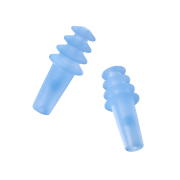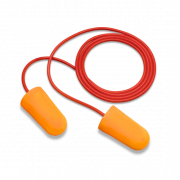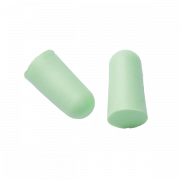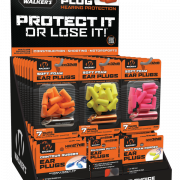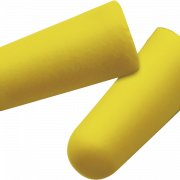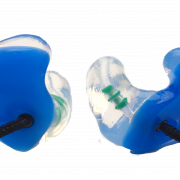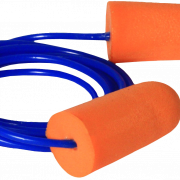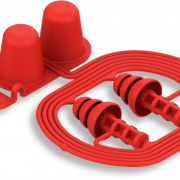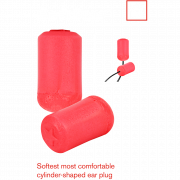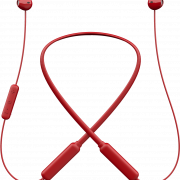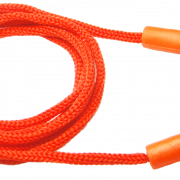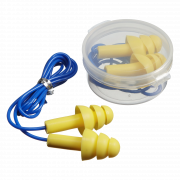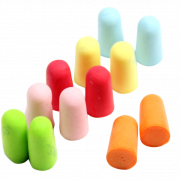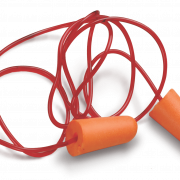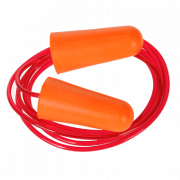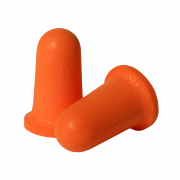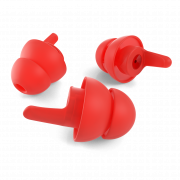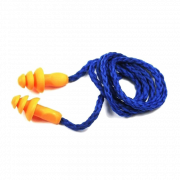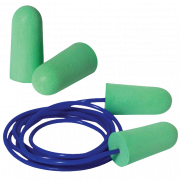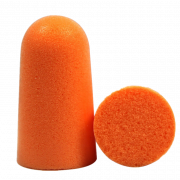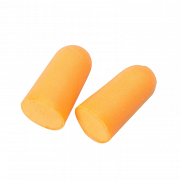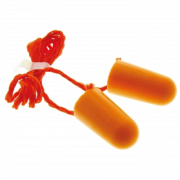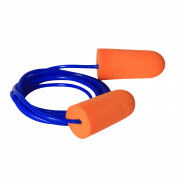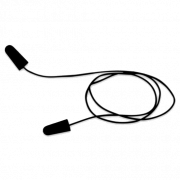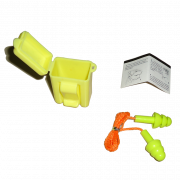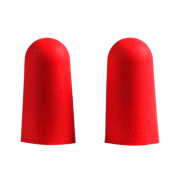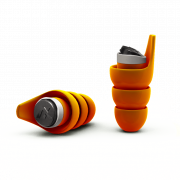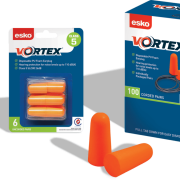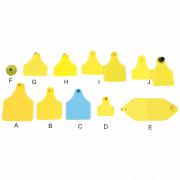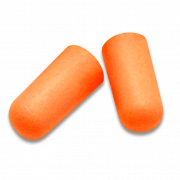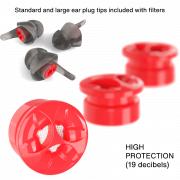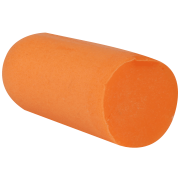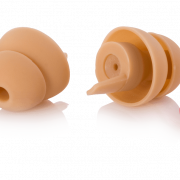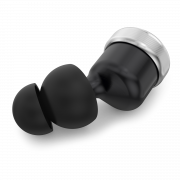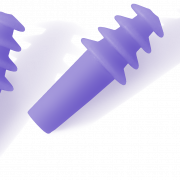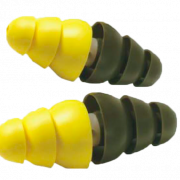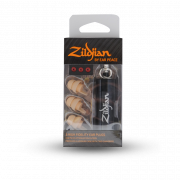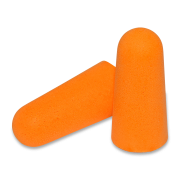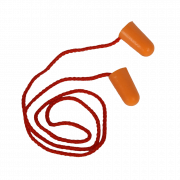Download top and best high-quality free Noise Reduction Ear Plug PNG Transparent Images backgrounds available in various sizes. To view the full PNG size resolution click on any of the below image thumbnail.
License Info: Creative Commons 4.0 BY-NC
An earplug is a device that is placed into the ear canal to protect the user’s ears from loud sounds, water incursion, foreign bodies, dust, and excessive wind. Earplugs are frequently used to help prevent hearing loss and tinnitus because they lower sound loudness (ringing of the ears).
The use of earplugs is first mentioned in the Greek epic Odyssey when Odysseus’ crew is warned of Sirens who sing from an island they will sail through. Circe, their hostess, informs them of the Sirens’ bewitching music, which causes men to abandon their boats and drown. She urged Odysseus to make earplugs out of beeswax for his men so they wouldn’t be lulled to death by the siren’s music.
Max Negwer, a German inventor, founded the German business Ohropax in 1907, which specialized in wax earplugs. In 1962, Ray and Cecilia Benner created the world’s first moldable pure silicone earplug. Swimmers and anyone wanting to avoid hazardous sounds favored these earplugs because of their waterproof characteristics. McKeon Products was purchased by Ray Benner, a classical pianist, in 1962. Mack’s Earplugs (named after the original owner) was the company’s only product at the time. It was a moldable clay earplug. Mack’s Pillow Soft Earplugs were soon modified by the Benners as a silicone version of the product.
Ross Gardner Jr. and his colleagues at the National Research Corporation (NRC) in the United States discovered the current earplug material in 1967. They created material with energy absorption characteristics as part of a project on sealing joints. This substance became known as “E-A-R.” (Energy Absorption Resin). The material was developed into commercial memory foam earplugs in 1972, using either polyvinyl chloride or polyurethane as the base.
For hearing protection, there are four major types of earplug fits.
Earplugs composed mostly of polyvinyl chloride (PVC) or polyurethane (PU) (memory foam) that are compressed (rolled) and inserted into the ear canal, where they expand to seal it.
Custom-molded earplugs that are produced from a mold of the wearer’s ear canal and are meant to suit all ear canal shapes perfectly. Laboratory-made and “formed in place” are two types of custom molded products.
When utilizing memory foam earplugs, NIOSH Mining Safety and Health Research suggests rolling, pulling, and gripping. Rolling the earplug into a thin rod, pulling back on the ear, and keeping the earplug deep in the ear canal with the finger are all steps in the procedure. The user must wait 20 to 30 seconds for the earplug to expand completely inside the canal in order to achieve a perfect seal.
Download Ear Plug PNG images transparent gallery.
- Ear Plug Equipment PNG High Quality Image
Resolution: 1080 × 1080
Size: 278 KB
Image Format: .png
Download
- Ear Plug Equipment PNG Images
Resolution: 700 × 560
Size: 170 KB
Image Format: .png
Download
- Hear Protection Ear Plug PNG HD Image
Resolution: 600 × 600
Size: 128 KB
Image Format: .png
Download
- Hear Protection Ear Plug PNG Photo
Resolution: 600 × 778
Size: 613 KB
Image Format: .png
Download
- Hear Protection Ear Plug PNG Clipart
Resolution: 600 × 600
Size: 278 KB
Image Format: .png
Download
- Ear Plug
Resolution: 817 × 600
Size: 411 KB
Image Format: .png
Download
- Hear Protection Ear Plug PNG
Resolution: 1941 × 1111
Size: 1388 KB
Image Format: .png
Download
- Hear Protection Ear Plug PNG Free Download
Resolution: 1313 × 769
Size: 987 KB
Image Format: .png
Download
- Hear Protection Ear Plug PNG Pic
Resolution: 1300 × 827
Size: 826 KB
Image Format: .png
Download
- Ear Plug PNG Images
Resolution: 1000 × 1000
Size: 464 KB
Image Format: .png
Download
- Ear Plug PNG Image File
Resolution: 1136 × 1191
Size: 356 KB
Image Format: .png
Download
- Ear Plug PNG
Resolution: 1429 × 695
Size: 947 KB
Image Format: .png
Download
- Ear Plug PNG Image
Resolution: 2000 × 2000
Size: 1418 KB
Image Format: .png
Download
- Ear Plug Transparent
Resolution: 1000 × 762
Size: 350 KB
Image Format: .png
Download
- Ear Plug PNG Clipart
Resolution: 1393 × 933
Size: 671 KB
Image Format: .png
Download
- Ear Plug PNG Free Download
Resolution: 1000 × 1231
Size: 74 KB
Image Format: .png
Download
- Ear Plug PNG Picture
Resolution: 1500 × 1500
Size: 945 KB
Image Format: .png
Download
- Hear Protection Ear Plug
Resolution: 2048 × 2048
Size: 1340 KB
Image Format: .png
Download
- Hear Protection Ear Plug PNG Image
Resolution: 700 × 700
Size: 243 KB
Image Format: .png
Download
- Hear Protection Ear Plug Transparent
Resolution: 720 × 689
Size: 359 KB
Image Format: .png
Download
- Ear Plug PNG Free Image
Resolution: 800 × 800
Size: 748 KB
Image Format: .png
Download
- Ear Plug Equipment
Resolution: 1000 × 1000
Size: 436 KB
Image Format: .png
Download
- Ear Plug Equipment PNG
Resolution: 800 × 800
Size: 277 KB
Image Format: .png
Download
- Ear Plug Equipment PNG Image
Resolution: 800 × 800
Size: 98 KB
Image Format: .png
Download
- Ear Plug Equipment Transparent
Resolution: 700 × 700
Size: 237 KB
Image Format: .png
Download
- Ear Plug Equipment PNG Clipart
Resolution: 1500 × 1500
Size: 714 KB
Image Format: .png
Download
- Hear Protection Ear Plug PNG Picture
Resolution: 934 × 534
Size: 64 KB
Image Format: .png
Download
- Hear Protection Ear Plug PNG Free Image
Resolution: 800 × 800
Size: 262 KB
Image Format: .png
Download
- Hear Protection Ear Plug PNG File
Resolution: 1280 × 1280
Size: 617 KB
Image Format: .png
Download
- Ear Plug Equipment PNG Picture
Resolution: 1000 × 1000
Size: 265 KB
Image Format: .png
Download
- Ear Plug PNG File
Resolution: 1024 × 675
Size: 84 KB
Image Format: .png
Download
- Ear Plug PNG HD Image
Resolution: 1000 × 1000
Size: 157 KB
Image Format: .png
Download
- Ear Plug PNG Pic
Resolution: 931 × 1000
Size: 329 KB
Image Format: .png
Download
- Ear Plug PNG Download Image
Resolution: 934 × 885
Size: 475 KB
Image Format: .png
Download
- Ear Plug PNG High Quality Image
Resolution: 934 × 534
Size: 76 KB
Image Format: .png
Download
- Ear Plug Equipment PNG Free Image
Resolution: 900 × 900
Size: 148 KB
Image Format: .png
Download
- Ear Plug Equipment PNG File
Resolution: 1678 × 656
Size: 148 KB
Image Format: .png
Download
- Hear Protection Ear Plug PNG Download Image
Resolution: 1680 × 1680
Size: 623 KB
Image Format: .png
Download
- Hear Protection Ear Plug PNG High Quality Image
Resolution: 1765 × 1052
Size: 522 KB
Image Format: .png
Download
- Hear Protection Ear Plug PNG Images
Resolution: 680 × 534
Size: 196 KB
Image Format: .png
Download
- Hear Protection Ear Plug PNG Image File
Resolution: 800 × 800
Size: 260 KB
Image Format: .png
Download
- Ear Plug Equipment PNG HD Image
Resolution: 900 × 900
Size: 579 KB
Image Format: .png
Download
- Ear Plug Equipment PNG Pic
Resolution: 1000 × 1000
Size: 311 KB
Image Format: .png
Download
- Ear Plug Equipment PNG Download Image
Resolution: 717 × 749
Size: 96 KB
Image Format: .png
Download
